Climatic Study of the Marine Surface Wind Field over the Greek Seas with the Use of a High Resolution RCM Focusing on Extreme Winds
Abstract
:1. Introduction
2. Materials and Methods
2.1. Materials
2.2. Methods
3. Results
3.1. Evaluation
3.2. Model
3.2.1. Seasonal Variability of Wind Speed and Direction
3.2.2. Extreme Wind Speed Thresholds
3.2.3. Seasonal Distribution of Extreme Winds
3.2.4. Return Levels
4. Discussion
5. Conclusions
- The high resolution (10 km) regional climate model (RegCM3) successfully captures the characteristic of the marine surface wind over the Greeks Seas.
- The model considered in this paper can successfully simulate the prevailing wind directions during the time periods when stability of the atmospheric circulation is observed (mainly during the summer months).
- Topography and local factors (buildings and vegetation) in the surrounding areas of the meteorological station can restrain the ability of the model to project the wind direction.
- The highest seasonal wind speeds occur during winter and are higher than 8 m/s over the Greek Seas.
- Wind speed is expected to decrease in the Ionian Sea at the end of the 21st century, while seasonal wind speeds will increase in the Aegean Sea during all seasons except autumn.
- The windiest regions over the Greek Seas are the southwest and the southeast Aegean Sea, with extreme threshold value up to 16 m/s. For the future, extreme wind speeds are expected to increase by 2 m/s in the north and 1.5 m/s in the south Aegean Sea, , and decrease in Ionian Sea.
- The highest seasonal excesses over the extreme wind thresholds are observed at the coastal regions of Greece and Turkey during winter, while the excesses move to the central and southeastern Aegean Sea during summer.
- The extreme wind values for 20, 50, 100, and 200-return periods were estimated. The largest changes in the return levels will occur in Northern Aegean Sea and Ionian Sea.
Acknowledgments
Author Contributions
Conflicts of Interest
References
- Kubota, M.; Yokota, H.J. Oceanogr Construction of surface wind stress fields with high temporal resolution using ERS-1. Scatt. Data 1998, 54, 247. [Google Scholar]
- Zecchetto, S.; Cappa, C. The spatial structure of the Mediterranean Sea winds revealed by ERS-1 scatterometer. Int. J. Remote Sens. 2001, 22, 45–70. [Google Scholar] [CrossRef]
- Seneviratne, S.I.; Nicholls, N.; Easterling, D.; Goodess, C.M.; Kanae, S.; Kossin, J.; Luo, Y.; Marengo, J.; McInnes, K.; Rahimi, M.; et al. Changes in climate extremes and their impacts on the naturalphysical environment. In Managing the Risks of Extreme Events and Disasters to Advance Climate Change Adaptation: A Special Report of Working Groups I and II of the Intergovernmental Panel on Climate Change (IPCC); Field, C.B., Barros, V., Stocker, T.F., Qin, D., Dokken, D.J., Ebi, K.L., Mastrandrea, M.D., Mach, K.J., Plattner, G.-K., Allen, S.K., et al., Eds.; Cambridge University Press: Cambridge, UK; New York, NY, USA, 2012; pp. 109–230. [Google Scholar]
- Mcvicar, T.R.; Van Niel, T.G.; Li, L.T.; Roderick, M.L.; Rayner, D.P.; Ricciardulli, L.; Donohue, R.J. Wind speed climatology and trends for Australia, 1975–2006: Capturing the stilling phenomenon and comparison with near surface reanalysis output. Geophys. Res. Lett. 2008, 35, 288–299. [Google Scholar] [CrossRef]
- McLnnes, K.L.; Macadam, I.; Hubbert, G.D.; O’Grady, J.G. A modeling approach for estimating the frequency of sea level extrems and the impact of climate change in southeast Australia. Nat. Hazards 2009, 51, 115–137. [Google Scholar] [CrossRef]
- Pirazzoli, P.A.; Tomasin, A. Recent near-surface wind changes in the central Mediterranean and Adriatic areas. Int. J. Climatol. 2003, 23, 963–973. [Google Scholar] [CrossRef]
- Sotillo, M.G.; Ratsimandresy, A.W.; Carretero, J.C.; Bentamy, A.; Valero, F.; González-Rouco, F. A high-resolution 44-year atmospheric hindcast for the Mediterranean Basin: contribution to the regional improvement of global reanalysis. Clim. Dyn. 2005, 25, 219–236. [Google Scholar] [CrossRef]
- Winterfeldt, J.; Andersson, A.; Klepp, C.; Bakan, S.; Weisse, R. Comparison of HOAPS, QuikSCAT and buoy wind speed in the eastern North Atlantic and the North Sea. IEEE Trans. Geosci. Remote Sens. 2010, 48, 338–348. [Google Scholar] [CrossRef]
- Zecchetto, S.; de Biasio, F. Sea surface winds over the Mediterranean basin from satellite data (2000–2004): Meso- and local-scale features on annual and seasonal time scales. J. Appl. Meteorol. Climatol. 2007, 46, 814–827. [Google Scholar] [CrossRef]
- IPCC: Managing the Risks of Extreme Events and Disasters to Advance Climate Change Adaptation. A Special Report of Working Groups I and II of the Intergovernmental Panel on Climate Change; Field, C.B.; Barros, V.; Stocker, T.F.; Qin, D.; Dokken, D.J.; Ebi, K.L.; Mastrandrea, M.D.; Mach, K.J.; Plattner, G.-K.; Allen, S.K.; et al. (Eds.) Cambridge University Press: Cambridge, UK; New York, NY, USA, 2012; p. 582. [Google Scholar]
- Weisse, R.; von Storch, H.; Feser, F. Northeast Atlantic and North Sea storminess as simulated by a regional climate model 1958–2001 and comparison with observations. J. Clim. 2005, 18, 465–479. [Google Scholar] [CrossRef]
- Rockel, B.; Woth, K. Extrems of near surface wind speeds over Europe and their future changes as estimated from an ensemble of RCM simulations. Clim. Chang. 2007, 81, 267–280. [Google Scholar] [CrossRef]
- Beniston, M.; Stephenson, D.B.; Christensen, O.B.; Ferro, C.A.T.; Frei, C.; Goyette, S.; Halsnaes, K.; Holt, T.; Jylhä, K.; Koffi, B.; et al. Future extreme events in European climate: an exploration of regional climate model projections. Clim. Chang. 2007, 81 (Suppl. 1), 71–95. [Google Scholar] [CrossRef]
- Haugen, J.E.; Iversen, T. Response in extremes of daily precipitation and wind from a downscaled multimodel ensemble of anthropogenic global climate change scenarios. Tellus 2008, 60, 411–426. [Google Scholar] [CrossRef]
- Rauthe, M.; Kunz, M.; Kottmeier, C. Changes in wind gust extremes over Central Europe derived from a small ensemble of high resolution regional climate models. Meteorol. Z. 2010, 19, 299–312. [Google Scholar]
- Bellucci, A.; Gualdi, S.; Masina, S.; Storto, A.; Scoccimarro, E.; Cagnazzo, C.; Fogli, P.; Manzini, E.A.; Navarra, A. Decadal climate predictions with a coupled OAGCM initialized with oceanic reanalyses. Clim. Dyn. 2013, 40, 1483–1497. [Google Scholar] [CrossRef]
- Walshaw, D. Modelling extreme wind speeds in regions prone to hurricanes. Appl. Stat. 2000, 49, 51–62. [Google Scholar] [CrossRef]
- Sheskin, D.J. Handbook of Parametric and Nonparametric Statistical Procedures; CRC Press: Boca Raton, FL, USA, 2003; p. 1192. [Google Scholar]
- Anagnostopoulou, C.; Tolika, K. Extreme precipitation in Europe: Statistical threshold selection based on climatological criteria. Theor. Appl. Climatol. 2011, 107, 479–489. [Google Scholar] [CrossRef]
- Emanuel, K.A. A scheme for representing cumulus convection in large-scale models. J. Atmos. Sci. 1991, 48, 2313–2329. [Google Scholar] [CrossRef]
- Emanuel, K.A.; Lvkovic-Rothman, M. Development and evaluation of a convective scheme for use in climate models. J. Atmos. Sci. 1999, 48, 1766–1782. [Google Scholar] [CrossRef]
- Tolika, K.; Anagnostopoulou, C.; Velikou, K.; Vagenas, C. A comparison of the updated very high resolution model RegCM3_10 km with the previous version RegCM3_25 km over the complex terrain of Greece: Present and future projections. Theor. Appl. Climatol. 2016, 126, 715–726. [Google Scholar] [CrossRef]
- Thomas, B.; Kent, E.; Swail, V.; Berry, D. Trends in ship wind speeds adjusted for observation method and height. Int. J. Climatol. 2008, 28, 747–763. [Google Scholar] [CrossRef]
- Coles, S. An Introduction to Statistical Modeling of Extreme Values; Springer: Berlin/Heidelberg, Germany, 2001. [Google Scholar]
- Davison, A.C.; Smith, R.L. Models for exceedances over high thresholds. J. R. Stat. Soc. Ser. B 1990, 52, 393–442. [Google Scholar]
- Scarrott, C.; Macdonald, A. A review of extreme value threshold es-timation and uncertainty quantification. REVSTAT–Stat. J. 2012, 10, 33–60. [Google Scholar]
- Ribatet, M. POT: Modelling peaks over a threshold. Threshold 2007, 5, 15–30. [Google Scholar]
- Begueria, S. Uncertainties in partial duration series modelling of extrems related to the choice of the threshold value. J. Hydrol. 2005, 303, 215–230. [Google Scholar] [CrossRef]
- Anagnostopoulou, C.; Zanis, P.; Katragkou, E.; Tegoulias, I.; Tolika, K. Resent past and future patterns of the Etesian winds based on regional scale climate model simulations. Clim. Dyn. 2014, 42, 1819–1836. [Google Scholar] [CrossRef]
- Tyrlis, E.; Lelieveld, J. Climatology and dynamics of the summer Etesian Winds over the Eastern Mediterranean. J. Atmos. Sci. 2013, 70, 3374–3396. [Google Scholar] [CrossRef]
- Bloom, A.; Kotroni, V.; Lagouvardos, K. Climate change impact of wind energy availability in the Eastern Mediterranean using the regional climate model PRECIS. Nat. Hazards Earth Syst. Sci. 2008, 8, 1249–1257. [Google Scholar] [CrossRef]
- Mclnnes, K.l.; Erwin, T.A.; Bathols, J.M. Global Climate Model projected changes in 10m wind speed and diraction due to anthropogenic climate change. Atmos. Sci. Lett. 2011, 12, 325–333. [Google Scholar] [CrossRef]
- Van De Vyver, H.; Delcloo, A.W. Stable estimations for extreme wind speeds. An application to Belgium. Theor. Appl. Climatol. 2011, 105, 417–429. [Google Scholar] [CrossRef]
- Caires, S. A Comparative Simulation Study of the Annual Maxima and the Peaks over-Threshold Methods. J. Offshore Mech. Arct. Eng. 2016, 138, 051601. [Google Scholar] [CrossRef]
- Pinto, J.G.; Ulbrich, U.; Leckebusch, G.C.; Spangehl, T.; Reyers, M.; Zacharias, S. Changes in storm track and cyclone activity in three SRES ensemble experiments with the ECHAM5/MPI-OM1 GCM. Clim. Dyn. 2009, 29, 195–210. [Google Scholar] [CrossRef]
- Makris, C.; Galiatsatou, P.; Tolika, K.; Anagnostopoulou, C.; Kombiadou, K.; Prinos, P.; Velikou, K.; Kapelonis, Z.; Tragou, E.; Androulidakis, Y.; et al. Climate change effects on the marine characteristics of the Aegean and Ionian Seas. Ocean Dyn. 2016, 66, 1603–1635. [Google Scholar] [CrossRef]
- Krestenitis, Y.N.; Androulidakis, Y.S.; Kontos, Y.N.; Georgakopoulos, G. Coastal inundation in the north-eastern Mediterranean coastal zone due to storm surge events. J. Coast. Conserv. 2011, 15, 353–368. [Google Scholar] [CrossRef]

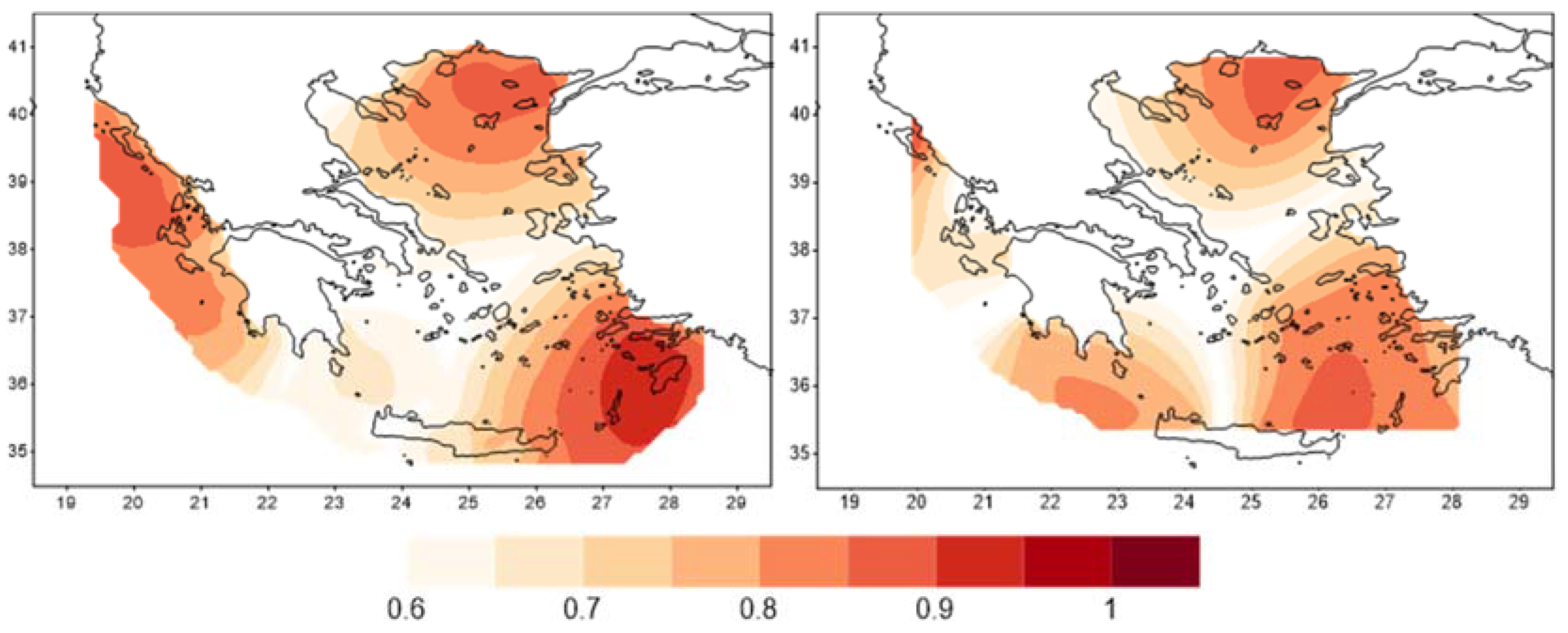
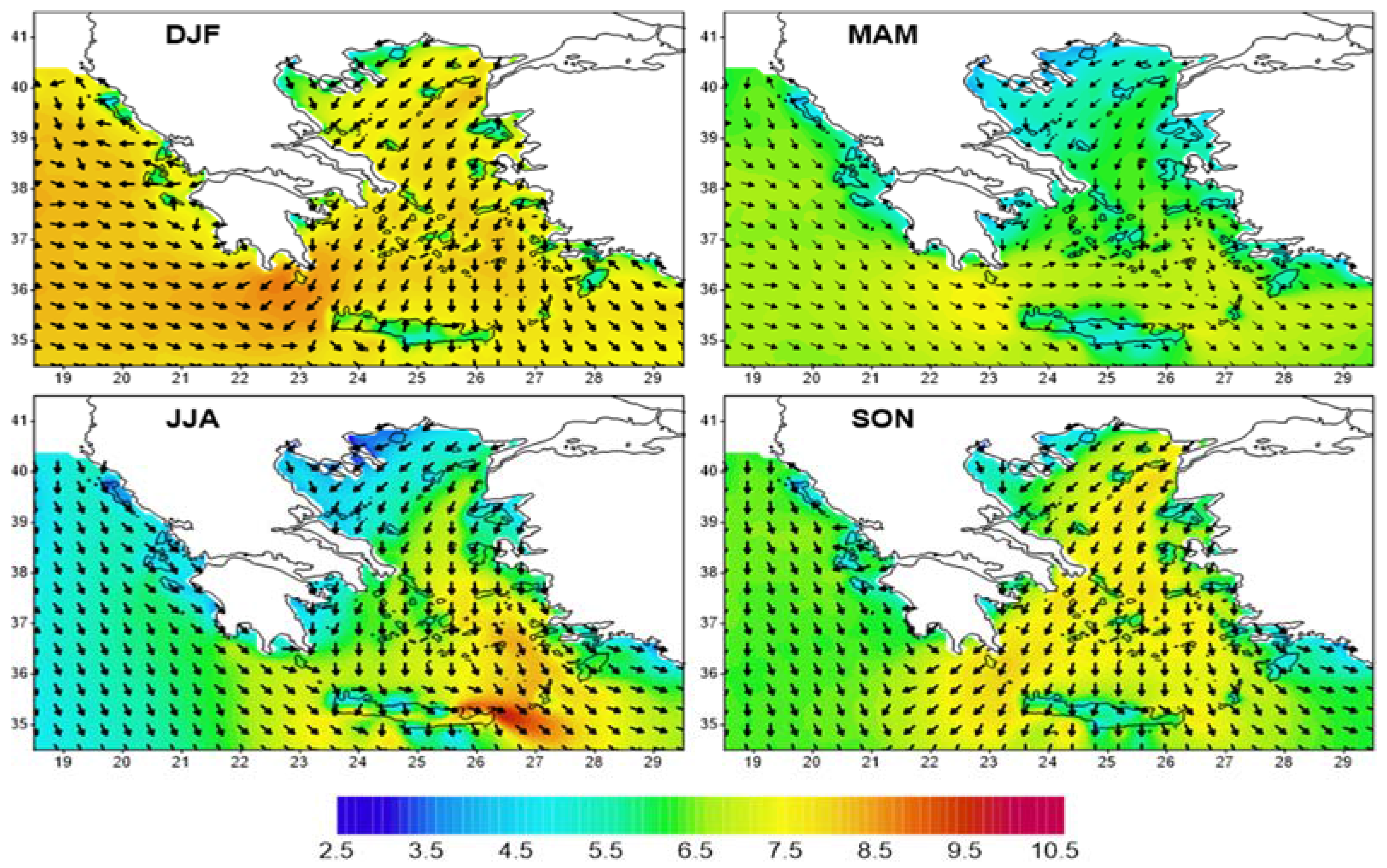
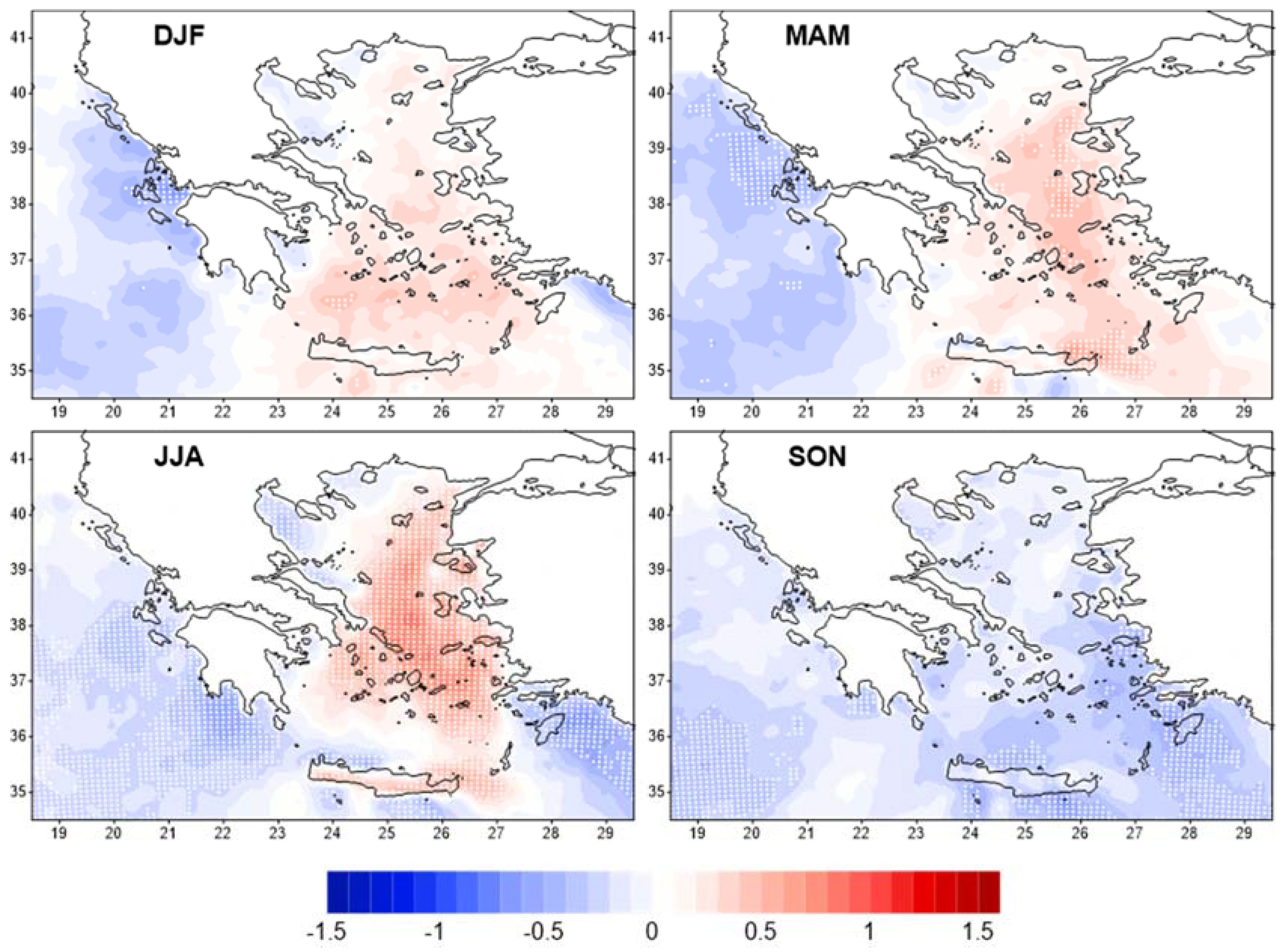

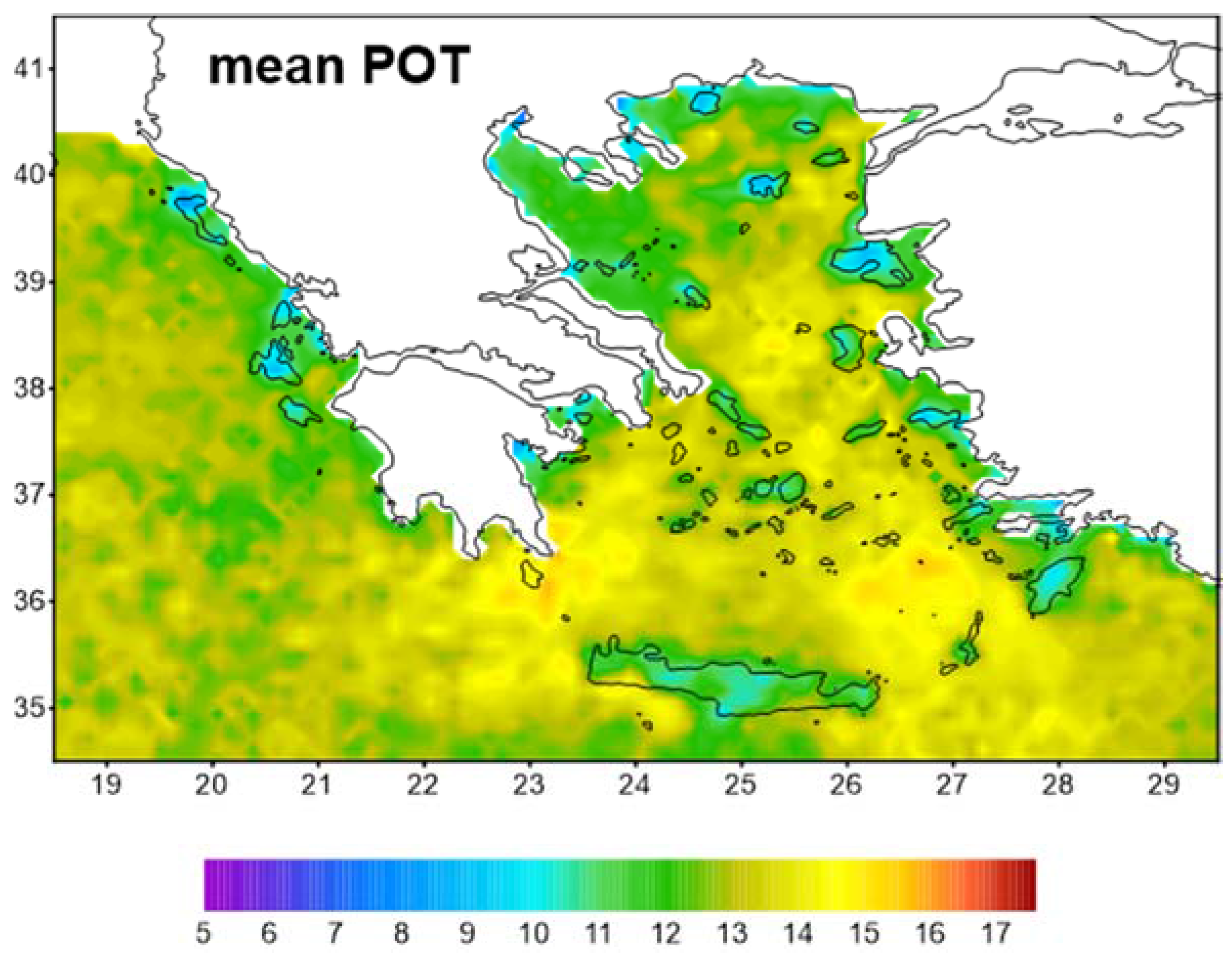
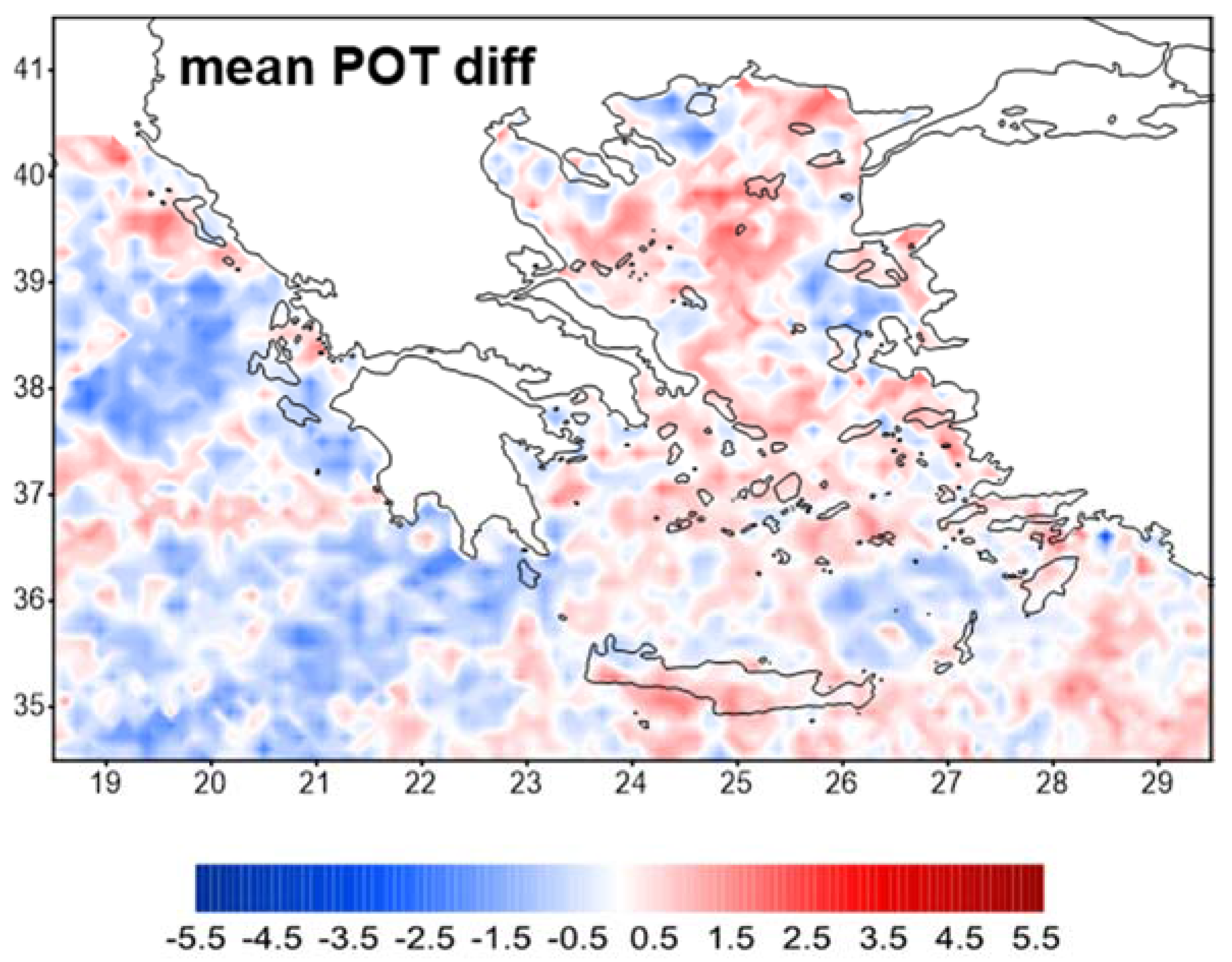

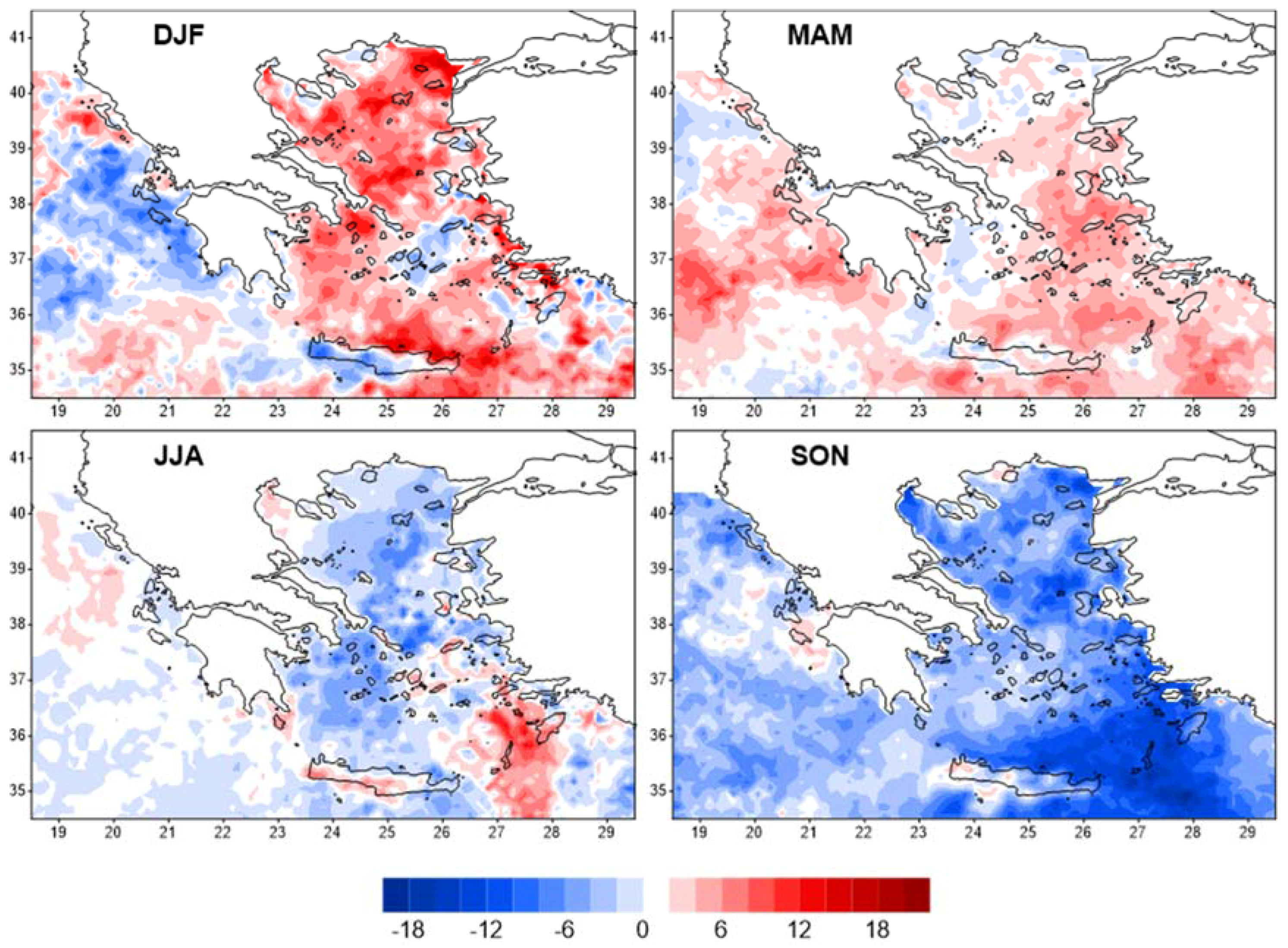


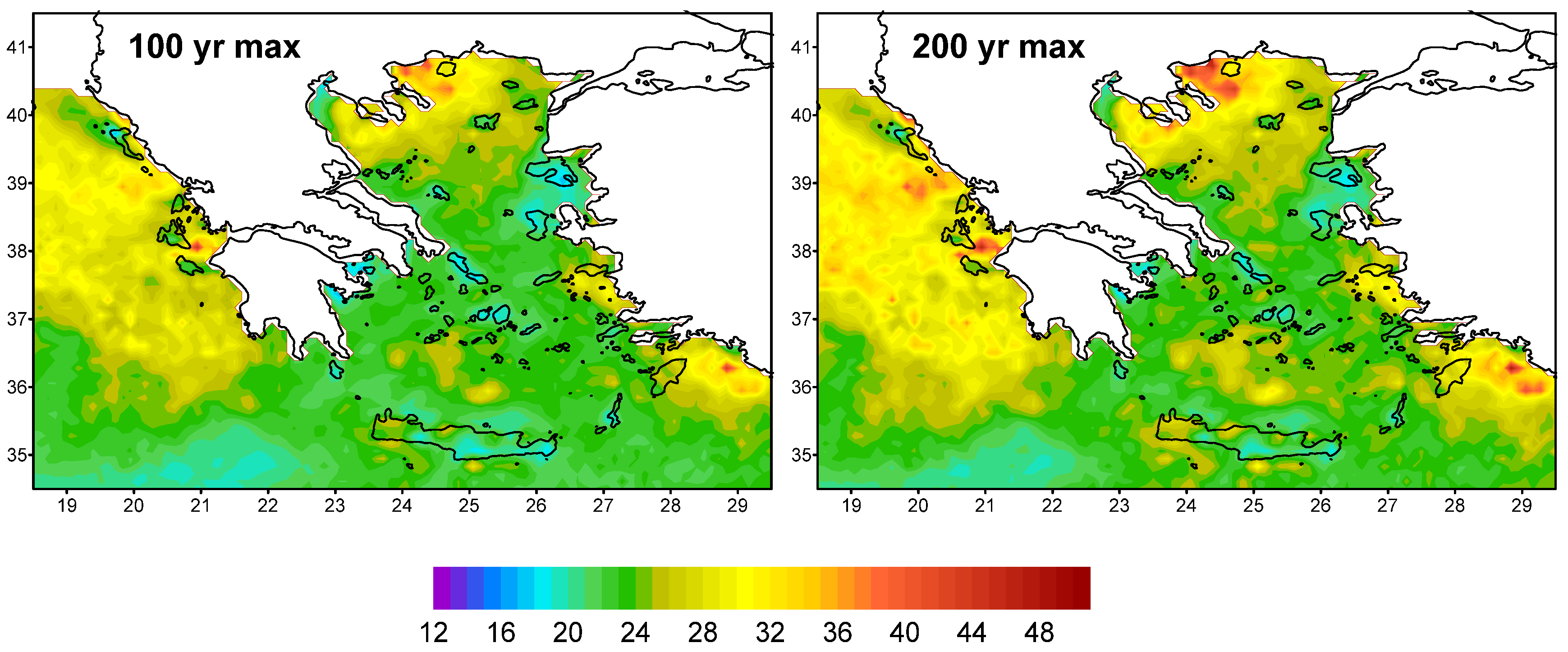
| Station | Model | |
|---|---|---|
| Winter | 78.5 | 92.0 |
| Spring | 74.4 | 90.1 |
| Summer | 77.7 | 89.6 |
| Autumn | 76.1 | 90.8 |
| NE Aegean | SE Aegean | SW Aegean | Ionian | |||||||||||||
|---|---|---|---|---|---|---|---|---|---|---|---|---|---|---|---|---|
| Alex/Poli | Lemnos | Skyros | Mytilene | Naxos | Samos | Rhodes | Heraklion | Milos | Souda | Kythira | Methoni | Andravida | Aktio | Kerkyra | ||
| Prevailing wind direction | DJF | 0 | 0 | 0 | 0 | 0 | 0 | 0 | 0 | 0 | 0 | 0 | 0 | 180 | 45 | 0 |
| MAM | 0 | 0 | 0 | 0 | 0 | 0 | 0 | 0 | 0 | −45 | −135 | 0 | −45 | −90 | 0 | |
| JJA | 0 | 0 | 0 | 0 | 0 | 0 | 45 | 0 | 0 | 0 | −90 | 0 | 0 | −45 | 0 | |
| SON | 0 | 0 | 45 | 45 | 0 | 0 | 45 | 0 | 0 | 0 | 0 | 0 | 45 | 180 | 0 | |
| Frequency of prevailing wind direction | DJF | |||||||||||||||
| MAM | ||||||||||||||||
| JJA | ||||||||||||||||
| SON | ||||||||||||||||
| Median speed of prevailing wind direction | DJF | |||||||||||||||
| MAM | ||||||||||||||||
| JJA | ||||||||||||||||
| SON | ||||||||||||||||
| Median wind speed | DJF | |||||||||||||||
| MAM | ||||||||||||||||
| JJA | ||||||||||||||||
| SON | ||||||||||||||||
| 95th percentile of wind speed | DJF | |||||||||||||||
| MAM | ||||||||||||||||
| JJA | ||||||||||||||||
| SON | ||||||||||||||||
© 2017 by the authors. Licensee MDPI, Basel, Switzerland. This article is an open access article distributed under the terms and conditions of the Creative Commons Attribution (CC BY) license (http://creativecommons.org/licenses/by/4.0/).
Share and Cite
Vagenas, C.; Anagnostopoulou, C.; Tolika, K. Climatic Study of the Marine Surface Wind Field over the Greek Seas with the Use of a High Resolution RCM Focusing on Extreme Winds. Climate 2017, 5, 29. https://doi.org/10.3390/cli5020029
Vagenas C, Anagnostopoulou C, Tolika K. Climatic Study of the Marine Surface Wind Field over the Greek Seas with the Use of a High Resolution RCM Focusing on Extreme Winds. Climate. 2017; 5(2):29. https://doi.org/10.3390/cli5020029
Chicago/Turabian StyleVagenas, Christos, Christina Anagnostopoulou, and Konstantia Tolika. 2017. "Climatic Study of the Marine Surface Wind Field over the Greek Seas with the Use of a High Resolution RCM Focusing on Extreme Winds" Climate 5, no. 2: 29. https://doi.org/10.3390/cli5020029






